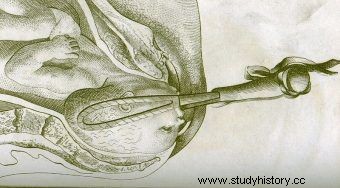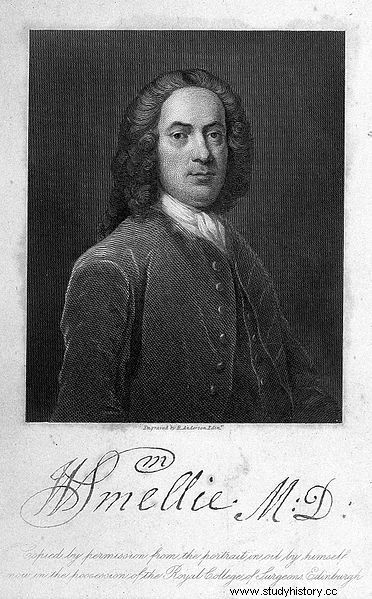From the beginning of civilization until recently, obstetrics was the domain of women. The situation did not change until the middle of the 18th century, and not without a serious brawl ...
The profession of midwife has been practiced for thousands of years. The earliest source describing the tasks and methods of conduct assisting women in pregnancy and childbirth is the Ebers Papyrus. This document was purchased by the Egyptologist Georg Ebers in 1873, and the date of its creation was set around 1550 BC. Westcar papyrus from around 1700 B.C.E. also contains provisions on the issue of childbirth, but only indirectly: we will find information on the calculation of the due date and on the different types of delivery chairs.

The delivery of childbirth by men for a long time generated a lot of controversy
In medieval times, delivering birth was still the task of women, but the recommendations and regulations concerning obstetric practice were taken care of by ... only men. No wonder there has finally been a breakthrough!
The man who has seen too much
"A man entering the delivery room was considered indecent, yet it was the men who wrote guides, disseminating guesswork-based advice passed down through generations," we read in Get Me Out:A History of Childbirth from the Garden of Eden to the Sperm Bank ”Randi Hutter Epstein. Eventually, there were those who even wanted to see childbirth to understand it better.
The first of the recorded attempts ended tragically. In 1522, Dr. Wert from Hamburg disguised himself as a woman and penetrated the door of the delivery room. But he was caught and sentenced… to death at the stake!

Ambroise Paré was an outstanding surgeon, but he was also interested in obstetrics
His story, however, must have inspired others. The renowned French surgeon Ambroise Paré, who treated the kings of Henry II, Francis II, Charles IX and Henry III, also paid attention to obstetrics. In the middle of the 16th century, he managed to restore, among other things, the ancient technique of turning a baby before delivery.
King Louis XIV also contributed to the changes, hiring male midwives to pick up his illegitimate children. Still, officially, men were not allowed to legally watch childbirths. That didn't change until the 18th century…
The dress question
Of course, it was not without chauvinism and accusations of dirty thoughts.
In the 18th century, more men appeared as midwives. They argued that assisting in childbirth requires medical skills and the use of tools, which exceed the competences of women. They, in turn, thought that newly minted doctors just wanted to see them naked
- writes Nathan Belofsky in the book "How It Was Treated In The Old Times:Moss Fills And Other Stories".
Here also appears the figure of William Smelli, a Scottish gynecologist who became one of the first British midwives. The beginnings, of course, were not easy. Riots broke out at the door of women giving birth under his care!

William Smellie
Therefore, Smellie began to dress up as a woman, following the example of the tragically deceased Wert. He recommended the same to his students. Tools could be hidden in the folds of the generous aprons, which turned out to be quite useful.
On the other side of the barricade, in the struggle for a place at birth, stood the then famous midwife Elizabeth Nihill, criticizing men for unexpected interest in anatomy of the fair sex and butchering methods. Ultimately, she lost the fight, and the gentlemen delivering the deliveries became normal ... Although the transfer of the procedure from the comfort of home to hospitals turned out to be a serious mistake!
Bad aura
Men as midwives were attacked for a number of reasons. Some of them were completely wrong. There were voices saying that a man should not deliver labor because he is incapable of delivering it himself and cannot imagine such a situation. Many opponents of course quoted the Scriptures, noting that men had never delivered births before. So why would they start doing this? The criticism also concerned the usual male jealousy - the midwife could be treated as an "intruder" in someone else's territory ...
On the other hand, there were also sane voices pointing to errors in "male" techniques. It was the midwives who used the tools, even when they were not needed. Taking into account the state of hygiene in hospitals, such behavior only increased the risk of infection, while deliveries delivered using "female" techniques were devoid of this additional risk. In addition, men who promoted a scientific approach over and above the folk knowledge of women recommended hospital births.

Men more often than women used unnecessary tools in childbirth
In 1846, the Hungarian physician Ignaz Semmelweis noticed that more women die in the delivery wards staffed with men than in those with midwives - women. He conducted an investigation and found out that he was dealing with an epidemic of postpartum infections caused by… inexperienced doctors not washing their hands! There have been occasions when they went directly from an autopsy to examining pregnant women ...
Fortunately, Louis Pasteur soon entered the stage. A French scientist described the pathology of postpartum infection and contributed to a significant improvement in hygiene - not only in medicine, but in all areas of life. The world had learned and accepted the knowledge of germs, and there was a straight path to modern delivery methods. Regardless of whether the newborn was greeted by a woman or a man.
Bibliography:
- Belofsky, N., How Was Treated Before, i.e. moss fillings and other stories. RM publishing house, Warsaw, 2014.
- Hutter Epstein, R., Get Me Out:A History of Childbirth from the Garden of Eden to the Sperm Bank. W. W. Norton &Company, 2010.
- Nelson, A., Men and Women in Midwifery. Wonders and Marvels, 2008,
- http://www.wondersandmarvels.com/2008/12/men-and-women-in-midwifery.html, accessed on July 20, 2020.
